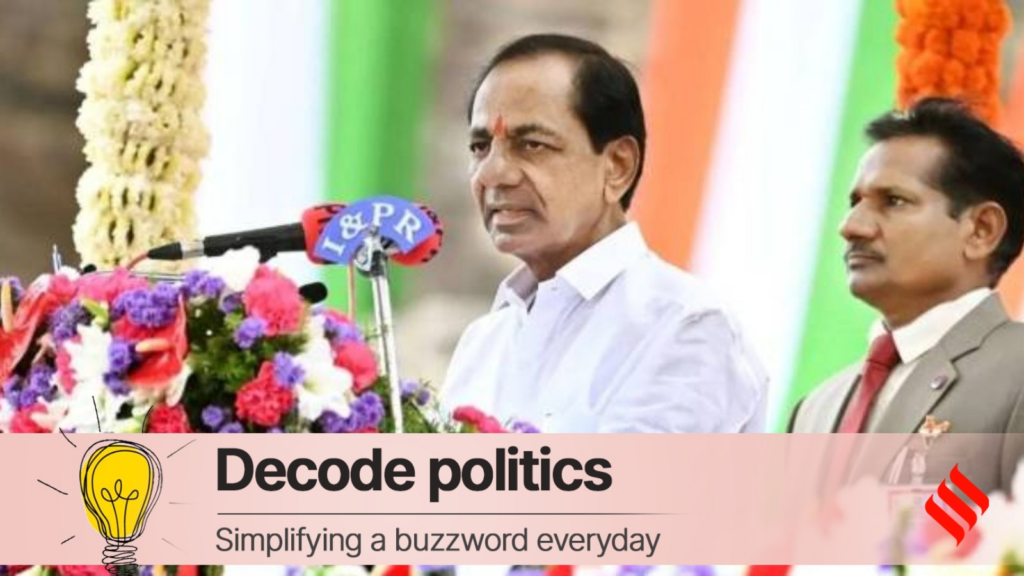Findings of the Justice P C Ghose Commission on the Kaleshwaram Lift Irrigation Project (KLIP) – seen to be the “crown jewel” of the Bharat Rashtra Samithi (BRS) – have come as a blow to former Telangana chief minister and party chief K Chandrashekar Rao.
The panel, which was set up by the A Revanth Reddy-led Congress government to probe alleged irregularities, negligence and lacunae in the design and construction of the Meddigadda, Annaram and Sundilla barrages, has held Rao – popularly known as KCR – accountable for the irregularities.
What is KLIP and what does it aim to achieve?
Sprawling on the Godavari over 500 km across 13 districts, with a canal network of 1,800 km, the KLIP is the world’s largest multi-stage lift irrigation project. The Rs 80,000 crore project was inaugurated in June 2019.
According to the project master plan, of the 240 thousand million cubic feet (TMC) of the project’s water, 169 TMC is meant for irrigation while 30 TMC is for the Hyderabad municipal area. A total of 16 TMC is meant for miscellaneous industrial uses, and 10 TMC is meant to provide drinking water to nearby villages.
The vast bulk of this water — 195 TMC — will come from the Medigadda Barrage. Twenty TMC will come from the Sripada Yellampalli project, and another 25 TMC will be groundwater
The project aims to provide drinking and irrigation water to about 45 lakh acres across 20 of the state’s 31 districts, apart from Hyderabad and Secunderabad.
What started the investigation?
On October 21, 2023, pillar number 20 of block 7 of the Medigadda Barrage sank, leading to flooding. Four days later, a team of the National Dam Safety Authority (NDSA) examined the pillar and held a meeting with Larsen & Toubro, the firm executing the project.
On February 13 last year, the Congress government asked the NDSA to carry out a “thorough inspection” of the design and construction of the three barrages. In March, the NDSA visited the three barrages.
On April 29, the Telangana government said that the NDSA had found “lack of proper geo-technical investigations, design deficiencies construction defects, failure of modelling studies, structural distress, absence of robust quality control, operation and maintenance failures, (and that) dam safety aspects (had been) ignored”.
Around the same time, the Reddy government also constituted the Ghose panel, which was mandated with inquiring into who could be held responsible for the “lapses”.
What are the Ghose Commission’s findings?
While the full report of the panel is yet to be made public, the commission has held KCR “solely responsible” for the decision to construct the three barrages.
The panel also observed that “non-availability” of water at Tummidi Hetti was not a genuine reason for shifting the barrage to Meddigadda and said that the decisions of “individuals” led to the shift.
“It can be said that there is rank irregularity from the stage of conceptualisation of Kaleshwaram project till the issuance of administrative approvals on March 1, 2016, for the construction of the three barrages. This is not the decision of the government but of individuals”.
Moreover, a retired engineers committee constituted by the BRS government had advised against the construction of a barrage at Medigadda, a recommendation that was set aside by KCR, the panel noted. “It is abundantly clear that the government has not considered the report of the expert committee… The government under the then CM K Chandrashekar Rao and Harish Rao as the then Minister for Irrigation have not considered the report of the expert committee,” the report stated.
What are the likely political implications for the BRS?
Often referred to as “Telangana’s lifeline” and seen to be a brainchild of KCR himself, the NDSA’s and Ghose panel’s adverse reports on it has given the Congress an opportunity to corner the BRS.
“Both reports are non-political and show how the project has failed. KCR is solely responsible for the irregularities which led to the collapse of the barrage,” state Irrigation Minister N Uttam Kumar Reddy said.
The BRS, however, has questioned why the Congress government has not made the Ghose panel report public. Former state Agriculture Minister Singireddy Niranjan Reddy said, “Is it right to make political accusations even before the full report is made public? The panel was formed just to target KCR.”
BRS working president K T Rama Rao said that the project still irrigates vast tracts of land. “It cannot be ruled out citing the sinking of just one pillar,” he said.

